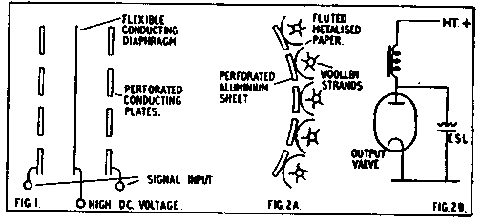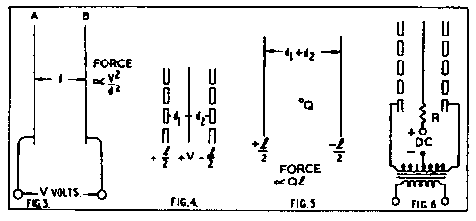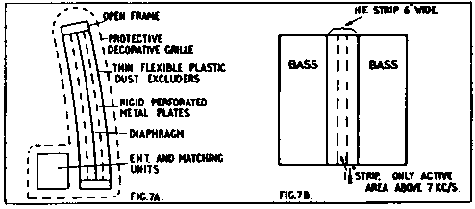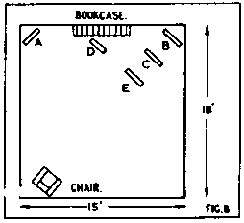Graciously provided to you by:
Massimo_de_Majo@mac.mermaid.dk
http://www.geocities.com/Vienna/1102
Hi-Fi News - November 1957
The Quad Electrostatic Speaker
by Ralph West
The recent appearance of a full range ESL designed and produced by a well-known manufacturer specialising in high quality reproduction, was bound to cause considerable comment and speculation. This speaker, the "Quad" electrostatic, is now in production, and we are pleased to present our readers with a full review of a specimen drawn from current production. The makers are The Acoustical Manufactoring Co. of Huntingdon, and it can be obtained through the usual channels. Price £52.
As the method of operation is quite different from that of current moving coil speakers, and it offers certain technical advantages-and, possibly even more important, as it is the first ESL in the world to reach this state of development-rather more space than usual is being allotted to this review. Much has already been written on the subject (see Hi-Fi Year Books, 1956 and 1957, and several past copies of Hi-Fi News), but a condensed story, sufficiently complete for the newcomer to appreciate the significance of this occasion, is hereby given.
(l) Basic principles stated very simply
There are many ways of converting electrical energy into sound, but only two main ways have been utilised successfully up to the present. One uses the interaction of magnetic fields produced by a flow of current, and has been developed to a very satisfactory level of performance in moving coil and ribbon speakers. The other uses the attraction and repulsion of electric charges, and though the existence of these forces has been known at least as long as our knowledge of magnetic forces, only quite recently have we been able to exploit it to our satisfaction. The bare essentials are shown in fig.1. A thin plastic sheet is given an electrically conducting coating and suspended between two rigid perforated metal plates. The plastic diaphragm is charged to a high voltage, and when signal voltages are applied to the outer plates, it will move, pulled one side and pushed on the other. As the signal is an alternating voltage, the diaphragm motion will be to and fro, and will drive air to and from through the perforated metal plates, this we shall hear as sound.

The first public demonstration of ES devices was in 1881, when Dolbear
exhibit a complete ES telephone system at the Paris Electrical Exhibition.
Between 1920 and 1935 several ES speakers and microphones were made, mainly
in Germany. In this country the Primustatic speaker retailed for
25s. in the early 1930s. It consisted of a single perforated aluminium sheet,
and a fluted metallised paper diaphragm. The insulation was partly a special
lacquer on the perforated sheet and partly the fluted paper, which was waxed.
Hairy strands of wool held the fluted diaphragm in place but allowed movement.
The whole was curved to produce wide-angle radiation of the higher frequencies.
The speaker was usually connected as in fg. 2B, when the PD between
anode and chassis partially collapsed the thin diaphragm on to the fixed
plate. Signals increased and decreased this PD, causing more and less attraction
respectively, and corresponding movement of the diaphragm and the air surrounding
it. It worked very well at high frequencies, but as the programme material
in those days had no high frequency content other than microphone hiss and
record surface noise, it never became popular. We will appraise its technical
capabilities later.
For the next twenty years. the only ES audio devices in general use were
condenser microphones. Some of these were superb, and one of them undoubtedly
played a vital role in the success of "ffrr" in its early
days.
While the mechanical simplicity remained a tantalizing attraction to acoustic
engineers, the known high distortion when used as a loudspeaker slowed further
development. Soon after, the Second World War provided other and more urgent
problems.
In 1954, Prof. F. V. Hunt's book "Electroacoustics" provided
the key to the distortion problem. He gave a very rigorous mathematical
examination of the ESL in various forms. His calculations showed that in
push-pull form. Iike fig. 1, it was capable of handling large signals
without much distortion if the diaphragm was given a constant charge
instead of a constant potential or voltage. The push-pull form
was not new; models were on sale in Germany around 1920! But the constant
charge idea was new and once more work began in ESL design.
By 1955, P. J. Walker of the Acoustical Manufacturing Co., had produced
two laboratory models, and these were demonstrated at the B.S.R.A. Annual
Exhibition in May, 1955. One was open back and front and handled middle
and high frequencies with amazing clarity. The other covered the whole frequency
range with equally good quality and used a large closed cabinet or infinite
baffle to maintain its bass response. The completely open type was further
developed to cover the whole frequency range, and in March, 1956, it was
demonstrated to the Physical Society in this form. This was the world's
first full-range ESL in open or doublet form.
Between these two events, H. J. Leak had demonstrated a very successful
ES tweeter (above 1,000 c.p.s.) and in America several ES tweeters appeared.
By April, 1956, at the Audio Fair three ES units were being demonstrated;
the newcomer was another fullrange model by Goodmans. The journey from laboratory
model to factory production is seldom easy, and this one is no exception
since it covers completely new ground. There are no one else's mistakes
to benefit from, and no one else's success to copy from! It is good going
to reach production at acceptable high-fidelity standards in a mere 4 years-the
moving coil speaker has had a 30-year start!
Engineers are sometimes upbraided for undue enthusiasm over the advent
of the ESL. (the writer is still unrepentant!) It is not without just cause.
For years, acoustic engineers have been trying to move air with devices
loaded with lumps of metal-iron (not recently), copper (very often), and
aluminium (in the better ones). The thing that actually pushes the air (the
diaphragm or cone) is rather heavy too. It has to be stiff enough for at
least most of it to move together, though it is only pushed at one place.
Now the moving parts of the ESL can be pretty well as light as we care to
make them. The driving force i equal all over the diaphragm, so it does
not have to be stiff enough to be rigid. It need be little thicker than
just sufficient to support itself. This gives it a tremendous advantage
as far as high note reproduction is concerned, and, what is probably even
more important, transient response.
Transient response concerns the ability of the system to respond with the
minimum time delay to the onset and the termination of a signal. If the
moving parts are heavy. considerable damping is necessary to bring it quickly
to a standstill. Even if one bit of the system stops, there is no guarantee
that all the rest of the moving parts stop at the same instant. If any or
all of the system carries on after the signal has stopped, then the sound
is blurred and coloured by the characteristic sound of that vibration.

In fairness to the moving coil speaker, the better samples we enjoy have
reduced these unwanted effects lo such small dimensions that they are not
obvious, not even to the experienced ear. However, the ESL having such a
fantastically small weight per unit working area, just doesn't suffer from
this trouble-or at least has no need to! (As far as the HF response is concerned,
the ribbon speaker, too, can give similar results.) Even the bass response
can be equally superior. If we can use a very large diaphragm, w cabinet
is necessary and therefore no cabinet resonances and consequent colouration
can occur. This is not very convenient with a single MC speaker, since the
necessity to retain a cone shape in the interests of rigidity, results in
a depth which is usually greater than half the diameter. A more suitable
alternative is to use several speakers of more acceptable size mounted on
a flat frame, and a very successful design of this type has appeared quite
recently.
However, the ESL again scores heavily, since even very large amplitudes
of movement are possible with very little distortion. The moving coil, unless
an extremely costly magnet design is used, tends to "run out of field"
at extremes of displacement. This leads to distortion and also to intermodulation,
which is more serious and more noticeable. The driving force on the
ESL diaphragm is undistorted for all deflections short of hitting the "stop".
At very low frequencies there will be a little distortion due to the stiffness
of the diaphragm necessary to prevent collapse. This is strictly comparable
with the non-linearity distortion of the MC due to its surround and centring.
The ESL is, however, practically free from intermodulation since the driving
force for the higher note component is still intact, whereas for the MC,
the driving force falls for large displacements as the coil is part way
out of the gap.
Summing up, We can expect clearer results and less colouration.
A further advantage arises with the choice of the doublet type speaker,
i.e., open back and front and radiating equally. At low frequencies where
its width (and height) is small compared with a wavelength it only radiates
energy in two directions-forwards and backwards in two very broad beams.
(t higher frequencies the beams are not so wide, but never become narrow
as the radiating width is reduced No energy then is radiated upwards, sideways,
or downwards, resulting in far less colouration due to the room. It particularly
reduces trouble due to eigentones.
(a) The simple ESL: Consider first a simple ESL consisting
of two elements only, e.g., Primustatic.
The steady force a2V 2 / d 2
Now apply a signal of e volts peak.
The maximum force a(V+e)2=V 2 +2Ve+e 2
The minimum force a(V-e)2=V 2-2Ve+e 2
The increase is a2Ve+e 2
The decrease is a2Ve-e 2
This latter is smaller and represents distortion, mainly second harmonic.
Worse than this, when the force increases, the distance d decreases, further
increasing the force. Results can only b acceptable, i.e., distortion small
if V is very much greater than e at all times and diaphragm movements are
small, i.e., small signal or as a tweeter.
(b) The push-pull ESL: If the diaphragm is central
when the polarising charge V only is applied, no movement occurs. Now apply
he signal voltages and the nett force becomes:

Now as long as the diaphragm remains central, d1=d2=d say, this expression
simplifies to Nett force 2Ve/d2 i.e.. it is proportional to the signal voltage
e. This means no distortion as Iong as its diaphragm doesn't move! Still
it was an improvement on the simple ESL, but not by any means good enough.
(c) The constant charge ESL: Referring back to
fig. 4, when the diaphragm is displaced to one side, the capacity
of that side increases whilst that of the other side decreases. A simple
check will show that the increase is bigger than the decrease. Therefore.
the nett capacity has increased, and some extra charge would have to flow
on to the diaphragm to maintain its voltage at V /olts. If we prevent this
flow, then its voltage will fall and the driving force will not rise so
much due to deflection-in fact, not at all! Stated simply, the force on
a fixed charge Q anywhere between the plates is only proportional
to the PD (e volts) between them. This, then, is truly distortionless. In
practice the "constant charge" has to be maintained against leakage
via a very high resistance. This is made so high that the charge on the
diaphragm doesn't vary appreciably during a half cycle of the lowest frequency
to be handled. The diaphragm, though conducting, must be of very
high resistance to prevent the charge "walling about" on it. Thus
not only must the charge be constant, but the charge per unit area must
also remain constant.

Dcscription: All domestic equipment has to be a compromise involving
size, weight, cost, technical complexity and performance shape, finish,
decor, etc. The moving coil systems, over a period of years, have settled
down to fairly stable designs-there cannot be very much real difference
in good speakers. With this new ESL speaker there is no design to
follow, to improve on, etc., etc. The designer has had to decide his own
selection of compromises and the general approval it has already received
at its various public demonstrations, has shown the wisdom in the present
choice. Time will tell whether we settle for this style, or some other.
Meanwhile, it is definitely in the front rank of the best loudspeakers,
on all scores.
The diagrams show most of the design features. high-note distribution is
ad achieved by progressively reducing the active width of 'diaphragm with
rise of frequency. In this speaker it is done in two main steps. The central
6in. strip at 1.000 c.p.s. has a polar distribution that will match that
of the whole area at low frequencies. Above about 7 Kc/s only the central
1 ins. radiates again helping to keep the beam reasonably wide.
In the vertical plane the HF strip is the full height and, if flat, would
produce a very narrow beam. The full length is needed to radiate The necessary
energy, so adequate beam "height" is produced by curving the speaker.
The EHT unit is a small 50 cycle ladder-type circuit delivering a few microamps,
at a few thousand volts for charging the diaphragm. It is therefore quite
non-lethal, even if exploration with a knitting needle were attempted! The
electrical consumption is negligible, barely more than the transformer iron
losses, a mere few watts. The heaviest part of it is the matching transformer.
This is a fairly high ratio step-up transformer having very low loss and
distortion, and a bulky low-capacity sectionalised secondary winding-probably
the most difficult bit to design!
Inspection with a torch shows the "rigid perforated plates" to
be very thick indeed-as they should be if they are to remain effectively
rigid at large amplitude low frequencies. The whole acoustic unit is sealed
between thin plastic films (,having negligible acoustic effect) to prevent
ingress of dust and moisture.
Overall height is 31ins., width 34 1/2 ins., and overall depth is lO 1/2
ins. Weight is 35 Ibs (16 Kilos) and it is thus easily moved by any adult
member of the household. The eternal finish of the present model has been
designed by Christopher Heal.
As this speaker presents a rather different load to the amplifier from that
of a moving coil type, certain requirements must be met. At frequencies
above 8 Kc/s it presents a capacitative load, just about the reverse of
a moving coil unit, which is inductive, as a rule, in this region.
It was designed to work with the Quad 11 amplifier, but any equivalent amplifier
can be used.
1. When adjusted to a fixed suitable output tap, the amplifier should
be capable of delivering at least 15 watts at low distortion when a resistive
load is varied between 30 ohms and 7 ohms.
2. The amplifier must be statically and dynamically stable completely regardless
of the resistance or reactance of the load. An inductance of up to 10 uH
may be inserted in series with the load during these tests.
3. With a 30 ohm resistive load, the amplifier should at no time be capable
of producing more than 35 peak volts across the loudspeaker terminals
4. The source impedance of the amplifier should be not more than 2 ohms
in the frequency range 100-5,000 c/s and not more than 6 ohms in the range
40-20,000 c/s. Ideally this impedance should be equivalent to a 1-2 ohm
resistor in series with a 40 µH inductance.
Performance: The reviewer has heard this speaker on many occasions
previously, in a wide variety of surroundings, including a pair, giving
stereo reproduction. The opinion formed, was that it did perform as the
very convincing theory suggested. Not until it was actually on the "home
pitch", however, was it realised how far this speaker is ahead.
There is no doubt music sounds very nice, more like the real thing than
ever before, speech, too, has lost all trace of boom- and that's not due
to lack of bass. Another interesting feature is the complete lack of any
fatigue effect, unless, of course, the programme quality is bad. All sensation
of listening to a loudspeaker is lost.
To make sure that the reviewer's judgment was not influenced by the thrill
of the technical novelty, a series of searching tests with familiar records,
BBC FM, white noise, rapid switchover to other excellent and familiar speaker
systems was performed to try and find where it excelled, where it did not,
and, if possibly, why.
Without doubt, the transient response was superior to anything yet experienced.
Several moving coil systems, notably a horn loaded one, could reproduce
the transients, but not with the complete lack of colouration that the ESL
could achieve. Well, this was expected, and now it has become actual fact.
Again, in fairness to the MC types, some of the best produce such slight
colouration of transient that it was only detected with certainty after
direct comparison with the ESL The "threat" of the ESL has certainly
produced remarkable progress in the MC field, so don't rush to throw them
all away just yet!
Record surface noise is noticeably lower than with any MC system with comparable
HF response, again demonstrating the freedom from HF resonances. (A horn-loaded
speaker of good design will also produce less surface noise, but unless
the horn design is very good and the crossover correctly balanced, it will
still colour this noise.)
When listening on or near the axis, the effect is as of an open window looking
directly on to the performance. It is a clearer, wider view than anything
hitherto, and the apparent distance away of the performer varies with the
microphone placing at the studio. Variation of the volume control will also
affect the apparent distance, of course. A few degree off the axis is often
better, as any distorted (slightly) top in the sound is less obtrusive.
Probably the most striking phenomenon is the fact that the resultant sound
sounds less like a loudspeaker than any previous experience has provided.
This is due to two things, first, the lack of colouration anywhere in the
frequency range. It has no noise of its own. Secondly. due to its doublet
form the room participates far less than usual. The listener is virtually
transported to a front balcony seat.
With slightly poorer quality signals, the speaker is still not wasted, though
the high frequency content would sound almost as good from a much cheaper
speaker. The lower register is still clean and uncoloured-"unobstructed"
is a word that comes to one's mind when listening to it. For some time now,
the reviewer has become aware of a peculiar sensation when listening to
many loudspeakers. It was as if a pillar, or similar obstruction, was situated
between the performance and the listener. This effect was practically absent
in one particular speaker, and is completely absent when listening to the
ESL. The phenomenon was explained by the realisation that diffraction of
sound round a solid object produces an uneven frequency response. Some frequencies
are boosted a little, some are attenuated-about as much as a fairly well
damped resonance would do. No resonance, flat response no apparent obstacle!
This is one of the main reasons for the expression "clear view"
involuntarily coming to mind.
Readers will have gathered by now, that this is not a device for impressing
the casual listener with one's Hi-Fi equipment. The top doesn't sparkle
all the time, and the bass doesn't shake one's tummy all the time. It merely
does what it's told, no more no less. The bass response below 45 c.p.s.
is down somewhat compared with many current loudspeakers, but it does not
spoil enjoyment of organ tone, rather the reverse. It does not make every
pedal stop sound like a big fat Bourdon! Every orchestral instrument is
treated perfectly, especially the large bass drum- it is no longer in a
big felt-lined box!

Various speaker positions were tried, and while the room does not appear
to participate so much, its position did have a considerable effect. Fig.
8, shows very roughly five positions tried. A and B were poor-and the
published leaflet warns thus. C was much better, D, close to but not parallel
to a low open (full) bookcase, was very good. E, similar to C, but closer,
was also very good. The lady of the house will probably insist on helping
to decide where it is placed, but never mind, it is not heavy to move!
To sum up: The "Quad" ESL is slightly ahead of all dynamic types
on transient response and freedom from colouration; it is a loudspeaker
designed to be listened to and enjoyed in the home, it will produce adequate
sound level for realistic results- it is not suitable for attempting to
show off "larger-than-life'- impressive noises. It will not suit all
tastes, but the reviewer can confidently recommend it as an excellent domestic
speaker. As Mr. Briggs has recently demonstrated really convincing stereophonic
reproduction with two completely dissimilar speakers, it is seriously suggested
that one of the listener's pair of speakers should be a full range electrostatic
p; the perfect excuse! R.LW.